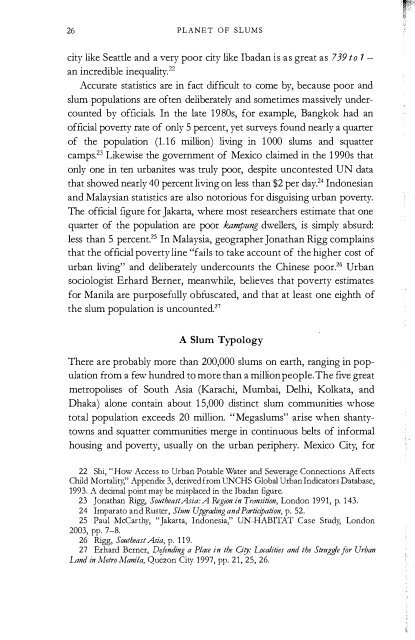Untitled - Rebel Studies Library
Untitled - Rebel Studies Library
Untitled - Rebel Studies Library
You also want an ePaper? Increase the reach of your titles
YUMPU automatically turns print PDFs into web optimized ePapers that Google loves.
26 PLANET OF SLUMS<br />
city like Seattle and a very poor city like Ibadan is as great as 739 to 1 -<br />
an incredible inequality.22<br />
Accurate statistics are in fact difficult to come by, because poor and<br />
slum populations are often deliberately and sometimes massively undercounted<br />
by officials. In the late 1980s, for example, Bangkok had an<br />
official poverty rate of only 5 percent, yet surveys found nearly a quarter<br />
of the population (1.16 million) living in 1000 slums and squatter<br />
camps.23 Likewise the government of Mexico claimed in the 1990s that<br />
only one in ten urbanites was truly poor, despite uncontested UN data<br />
that showed nearly 40 percent living on less than $2 per day.24 Indonesian<br />
and Malaysian statistics are also notorious for disguising urban poverty.<br />
The official figure for Jakarta, where most researchers estimate that one<br />
quarter of the population are poor kampung dwellers, is simply absurd:<br />
less than 5 percent.25 In Malaysia, geographer Jonathan Rigg complains<br />
that the official poverty line "fails to take account of the higher cost of<br />
urban living" and deliberately undercounts the Chinese poor.26 Urban<br />
sociologist Erhard Berner, meanwhile, believes that poverty estimates<br />
for Manila are purposefully obfuscated, and that at least one eighth of<br />
the slum population is uncounted.27<br />
A Slum Typology<br />
There are probably more than 200,000 slums on earth, ranging in population<br />
from a few hundred to more than a million people. The five great<br />
metropolises of South Asia (Karachi, Mumbai, Delhi, Kolkata, and<br />
Dhaka) alone contain about 15,000 distinct slum communities whose<br />
total population exceeds 20 million. "Megaslums" arise when shantytowns<br />
and squatter communities merge in continuous belts of informal<br />
housing and poverty, usually on the urban periphery. Mexico City, for<br />
22 Sbi, "How Access to Urban Potable Water and Sewerage Connections Affects<br />
Child Mortality," Appendix 3, derived from UNCHS Global Urban Indicators Database,<br />
1993. A decimal point may be misplaced in the Ibadan figure.<br />
23 Jonathan Rigg, SoutheastAsia: A Region in Transition, London 1991, p. 143.<br />
24 Imparato and Ruster, Slum Upgrading and Participation, p. 52.<br />
25 Paul McCarthy, "Jakarta, Indonesia," UN-HABITAT Case Study, London<br />
2003, pp. 7-8.<br />
26 Rigg, Southeas t Asia, p. 119.<br />
27 Erhard Berner, Defending a Place in the City: Localities and the Struggle for Urban<br />
Land in Metro Manila, Quezon City 1997, pp. 21, 25, 26.<br />
THE PREVALENCE OF SLUMS 27<br />
example, in 1992 had an estimated 6.6 million low-income people living<br />
contiguously in 348 square kilometers of informal housing.28 Most of<br />
the poor in Lima, likewise, live in three great peripheral conos radiating<br />
from the central city; such huge spatial concentrations of urban poverty<br />
are also common in Africa and the .Middle East. In South Asia, on the<br />
other hand, the urban poor tend to live in a much larger number of<br />
distinct slums more widely dispersed throughout the urban fabric in<br />
patterns with an almost fractal complexity. In Kolkata, for instance,<br />
thousands of thika bustees - nine hutments of five huts each, with 45square-meter<br />
rooms shared, on average, by an incredible 13.4 people -<br />
are intermixed with a variety of other residential statuses and landuses.29<br />
In Dhaka, it probably makes more sense to consider the nonslum areas<br />
as enclaves in an overwhelming matrix of extreme poverty.<br />
Although some slums have long histories - Rio de Janeiro's first<br />
fovela, Morro de Providencia, was founded in the 1880s - most<br />
megaslums have grown up since the 1960s. CiudadNezahualc6yotl, for<br />
example, had barely 10,000 residents in 1957; today this poor suburb<br />
of Mexico City has three miJJion inhabitants. Sprawling Manshiet N asr,<br />
outside Cairo, originated as a camp for construction workers building<br />
the suburb of Nasr City in the 1960s, while Karachi's vast hill slum of<br />
Orangi/Baldia, with its mixed population of Muslim refugees from<br />
India and Pathans from the Afghan border, was founded in 1965. Villa<br />
El Salvador - one of Lima's biggest bam'adas - was established in 1971<br />
under the sponsorship of Peru's military government, and within a few<br />
years had a population of more than 300,000.<br />
Everywhere in the Third World, housing choice is a hard calculus of<br />
I confusing trade-offs. As the anarchist architect John Turner famously<br />
pointed out, "Housing is a verb." The urban poor have to solve a<br />
complex equation as they try to optimize housing cost, tenure security,<br />
quality of shelter, journey to work, and sometimes, personal safety. For<br />
some people, including many pavement-dwellers, a location near a job<br />
- say, in a produce market or train station - is even more important<br />
than a roof. For others, free or nearly free land is worth epic commutes<br />
from the edge to the center. And for everyone the worst situation is a<br />
28 Keith Pezzoli, Human Settlements and Planningjor Ecological Sustainability: The Case<br />
of Mexico City, Cambridge 1998, p. 13.<br />
29 Nitai Kundu, "Kolkata, India," UN-HABITAT Case Study, London 2003, p. 7.


